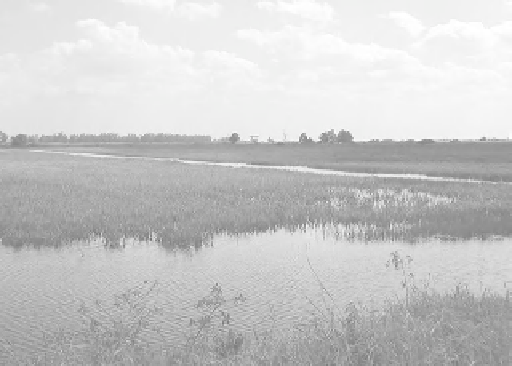Environmental Engineering Reference
In-Depth Information
have an important role in controlling the quality of
surface waters, and because of their role in removing
many anthropogenic pollutants and nutrients in surface
waters, wetlands are sometimes called “the kidneys of
the landscape.”
receive most of their water from surface runoff, and
many marshes are directly connected to the groundwa-
ter. Marshes typically recharge the groundwater and
moderate stream flow by providing water to streams,
which is an especially important function during periods
of drought. The presence of marshes in a watershed
reduces damage caused by floods because they slow and
store floodwater. Marshes are very important in pre-
serving the quality of surface waters. As water moves
slowly through a marsh, sediment and other pollutants
settle to the bottom of the marsh. Vegetation and micro-
organisms found in marshes utilize excess nutrients that
can otherwise pollute surface water.
Marshes are sometimes further subclassified. A
marsh with significant standing water and depth greater
than 30 cm (1 ft) throughout much of the year is some-
times called a
deepwater marsh
, while a shallow marsh
with waterlogged soil is sometimes referred to as a
sedge
meadow
or a
wet meadow
(Mitsch and Gosselink, 2007).
Intermediate between a marsh and a meadow is a
wet
prairie
.
Freshwater marshes have larger and more diverse
plant populations than saltwater or tidal marshes, and
irregularly flooded salt marshes exhibit the fewest
species of plants. Saltwater marshes are typically com-
posed mainly of rushes, sedges, and grasses. Animals
seek refuge from predators in the thick marsh vegeta-
tion. After marsh plants die, microorganisms break the
plants down into detritus, which serves as a food source
for many small animals.
8.2.1 Classification
Natural wetlands can be broadly classified as either
coastal wetlands or inland wetlands, where coastal wet-
lands are influenced by alternate floods and ebbs of
tides, and inland wetlands are nontidal. Coastal wet-
lands may be further categorized as either marine or
estuarine wetlands (Chang, 2002), depending on whether
they are adjacent to an open ocean or adjacent to an
estuary. In contrast to coastal wetlands, inland wetlands
are most common on floodplains along rivers and
streams (
riverine wetlands
), in isolated depressions sur-
rounded by dry land (
palustrine wetlands
), along littoral
zones of lakes and ponds (
lacustrine wetlands
), and in
other low-lying areas where the groundwater intercepts
the soil surface or where precipitation regularly satu-
rates the soil. riverine and lacustrine wetlands are
sometimes collectively referred to as
riparian wetlands
.
Wetlands are typically subclassified as marshes, swamps,
bogs, or fens.
8.2.1.1 Marshes.
Marshes
are wetlands that are fre-
quently or continually inundated with water and are
characterized by emergent soft-stemmed vegetation
that is adapted to saturated-soil conditions. A typical
marsh is illustrated in Figure 8.1. There are many differ-
ent kinds of marshes, ranging from
prairie potholes
in
the central and northern United States to the Ever-
glades in Florida. Marshes are found in coastal and
inland areas, and can contain fresh or salt water. Marshes
8.2.1.2 Swamps.
A
swamp
is any wetland dominated
by wood plants, and are characterized by saturated soils
during the growing season and standing water during
portions of the year. Swamps serve vital roles in flood
protection, nutrient removal, and sediment removal.
Swamps are divided into two major categories, depend-
ing on the type of vegetation present: forested swamps
and shrub swamps.
Forested Swamps. Forested swamps
are often inun-
dated with floodwater from nearby rivers and streams.
A typical forested swamp is illustrated in Figure 8.2. In
very dry years, they may represent the only shallow
water for kilometers, and their presence is critical to
the survival of wetland-dependent species, such as
wood ducks (
Aix sponsa
), river otters (
Lutra canaden-
sis
), and cottonmouth snakes (
Agkistrodon piscivorus
).
Common species of trees found in forested wetlands
are red maple and pin oak (
Quercus palustris
) in the
northern United States, overcup oak (
Quercus lyrata
)
and cypress (
Taxodium
spp.) in the south, and willows
(
Salix
spp.) and western hemlock (
Tsuga
spp.) in the
northwest.
Figure 8.1.
Typical marsh.

Search WWH ::

Custom Search